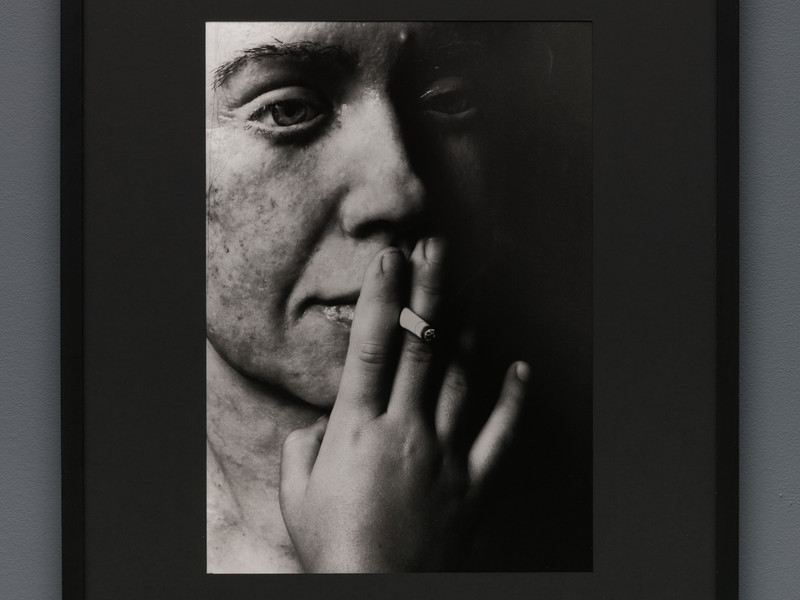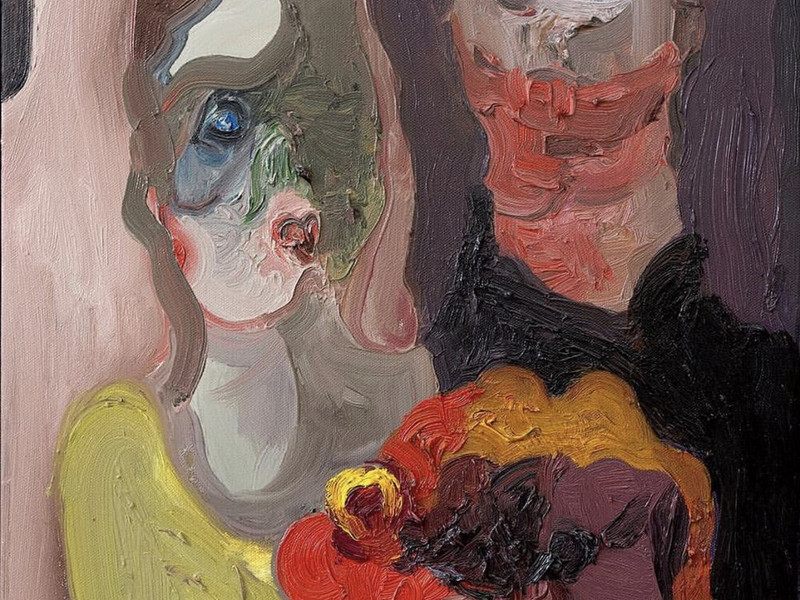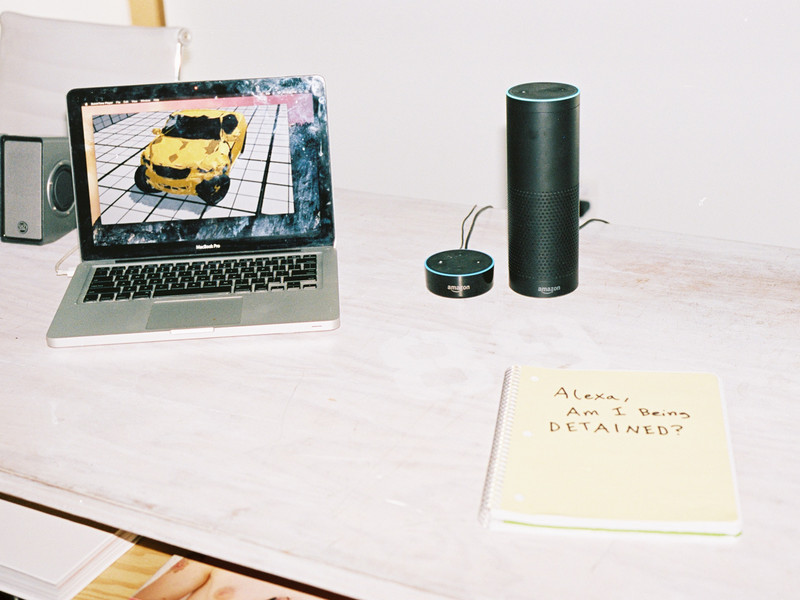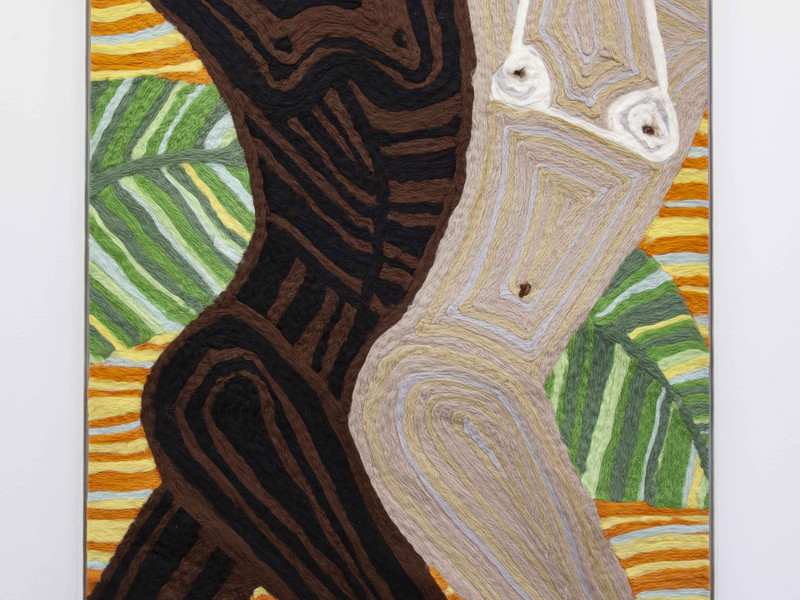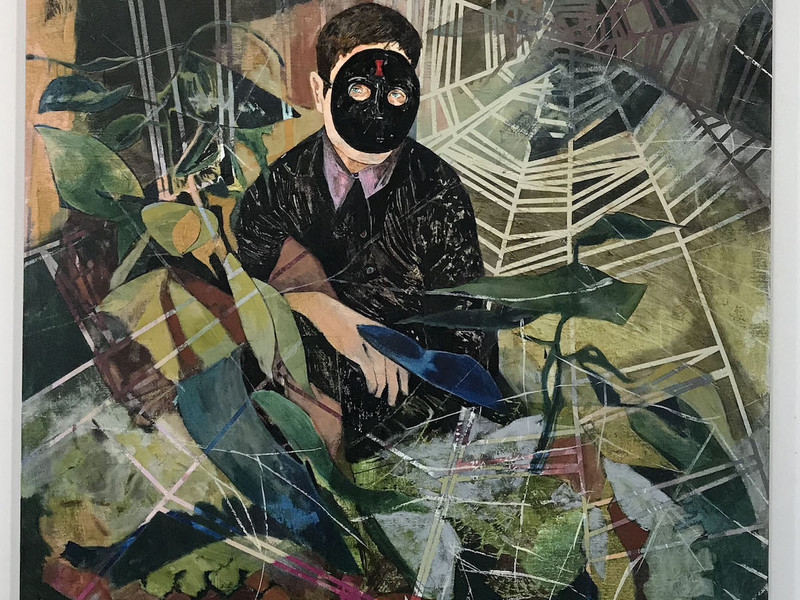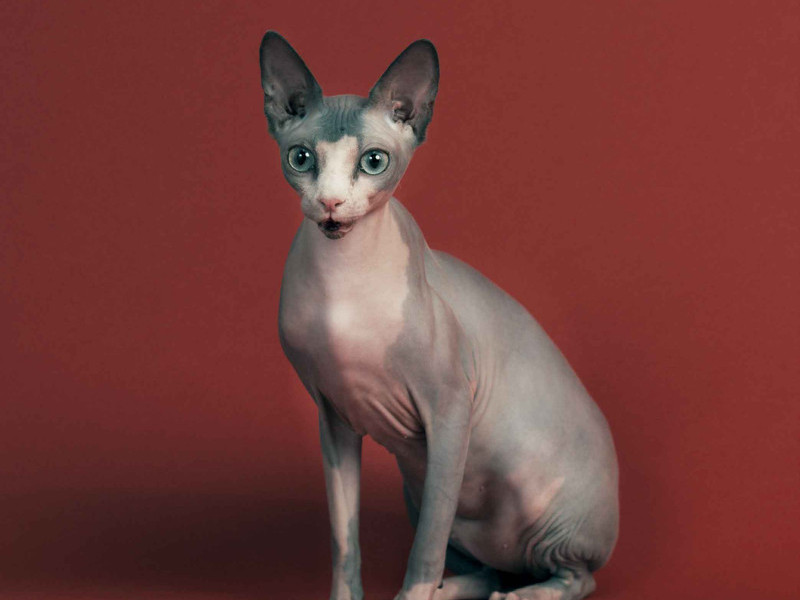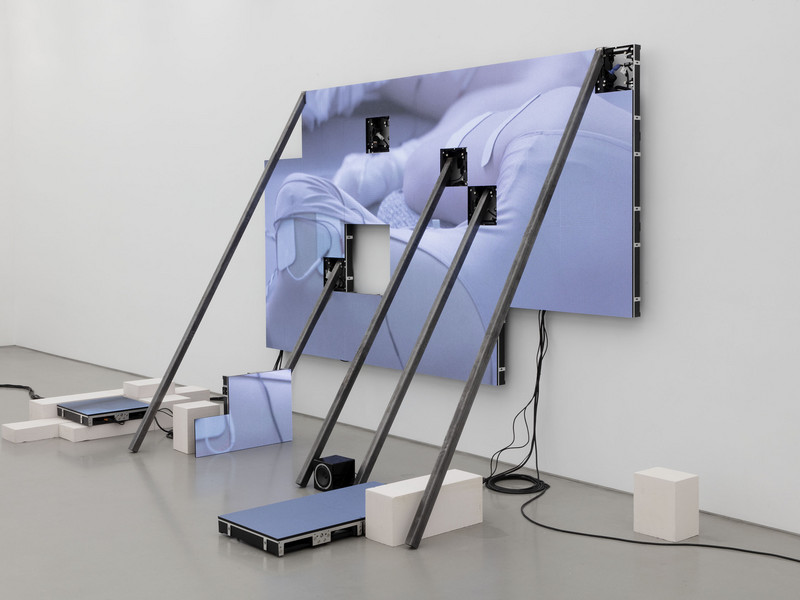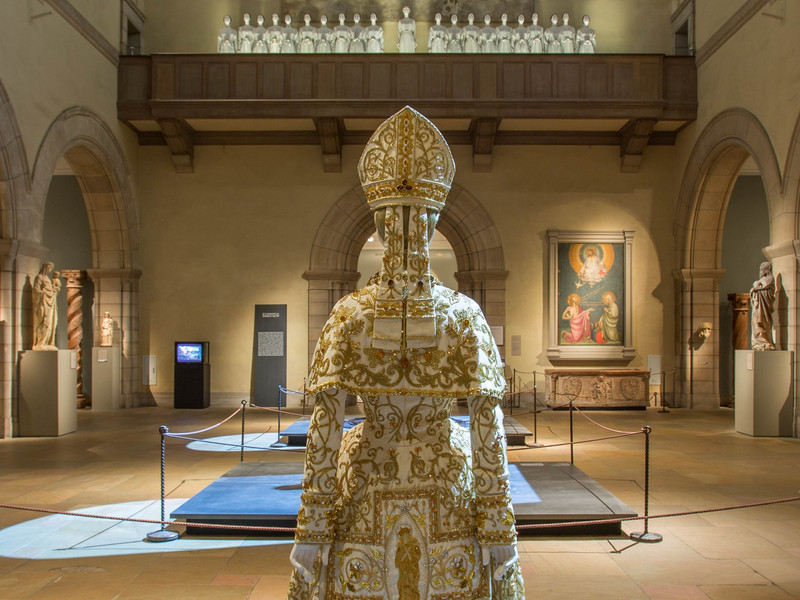Defining the Grey Area With Robert Gallardo
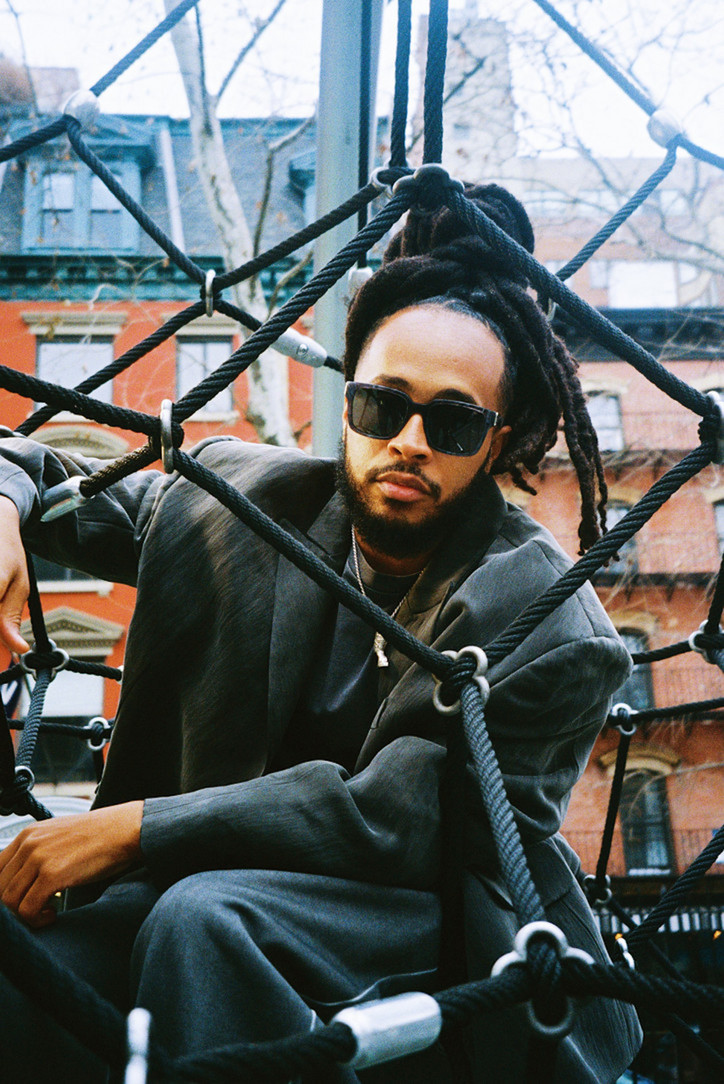
Jacket WILLY CHAVARRIA, pants BURBERRY, top MAISON MARGIELA, sunglasses LOUIS VUITTON, necklace TALENT'S OWN.
So how are you? How's life at the moment?
Life is good and calm. It's good and calm. I say calm because it hasn't been this calm… ever, I don't think. Since I've been an adult. But life is calm.
Is that how you like it?
Yeah, I prefer it like that. Yeah.
Because I know a lot of artists thrive off chaos. Others like it calm.
If art was the thing that I orient my life around, then I’d prefer the chaos. But I'm not making any art right now and I think it is partly because it's calm. I can see if I was an artist that needed to make art to make a living, I’d probably prefer the chaos, so I’d keep creating.
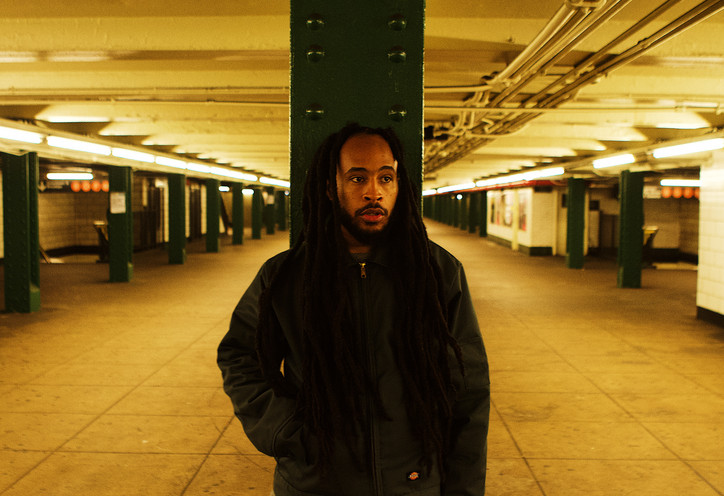
Jacket DICKIES.
How would you describe yourself as an artist?
An observer. I think I have an ability to simplify complex ideas into an image or a couple words. And so I'd say I'm an observer and a simplifier.
You do have quite a minimalist style, but then you work with artists like Rocky, who I've seen you describe as a maximalist. Do you find it easy to adapt to other people's style and make that work? Is that something that comes easy for you?
Yeah, I'd say so. One of my weaknesses is that I am impressionable. But in the context of being a creative consultant, it works because I have to be what I need to be in any given situation. I use my skills of simplifying, even when I'm adapting to other people's styles and ways of working. Even Rocky, one of the main things I do around him is kind of listening to what's going on and being like, 'oh, I think this is missing.' Or 'oh, I think we should do this with all the information that I just took in.' So, I think it works for me.
Having worked with established artists like him on their cover art, you've now developed the Cover Art Studio app. Can you tell me more about the app and why you wanted to create this platform for upcoming artists?
Even before I worked with Rocky, or bigger artists like that, I was working with local artists; that's how I started realizing that I wanted to do this kind of thing for a living. All my friends make music, and I did videos and covers for all of them for years. When I started doing bigger artists and industry stuff, the time that I had to do work for local artists wasn't there anymore. I think the idea was born in the void of not being able to do as much for local artists. I won't say that it was me directly trying to figure out what I can do for local artists, but the idea was definitely born in that time period of transitioning into working with established artists versus local artists. So, it had something to do with that, for sure. And I just saw a void. I know artists that would drop more music if they had album covers or single artworks.
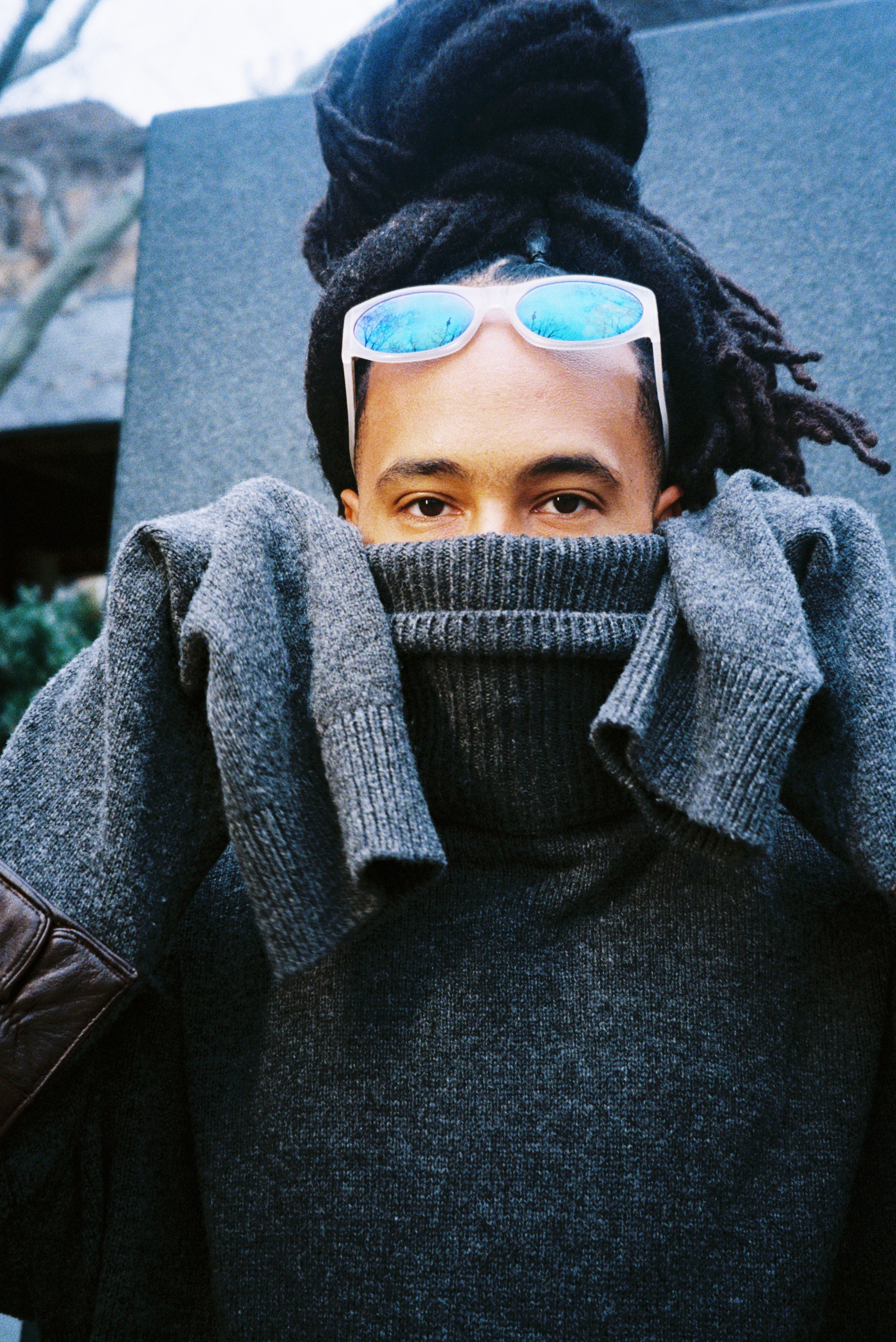

Left: sweater RAF SIMONS, sunglasses FLATLIST. Right: Sunglasses and jumpsuit TALENT'S OWN.
You’ve been wearing all grey for over seven years now. How and when did that start?
Yeah, so from July 17th, 2015. And like the cover art thing, or just any kind of idea for me, it wasn't like an 'aha' moment where I decided to wear all grey every day forever. Different things kept happening that would lead me to that. Part of it was some of my favorite artists, like Andy Warhol and even Picasso had a uniform. Steve Jobs had a uniform as well. So, me knowing that influenced the idea, but not directly. It wasn't like everyone has a uniform, so I want a uniform. It was more, okay, I know that information, then time passes and oh, I want a uniform. What would my uniform be? Is it going to be military? Is it going to be blue collar? Going through these different ideas. And then Jay-Z has a lyric, “might wear all black for a year straight”, which probably was part of it as well. And then I saw the green lady from New York. She’s been wearing green for a crazy number of years. So, it's all these things. Okay, maybe I can wear one color. What color would that be? And settling on grey being the least insane color to choose to wear every day. All white is pretentious, all black is obvious. Everybody does all black. All green is crazy. I mean, I love how she does it, but...
It's a lot.
All red, I might get killed going to LA. So, settling on grey was just my pragmatic mind figuring out what was the best solution for this problem of me wanting a uniform so that people can identify me with. And also give me a thing as an artist, you know what I mean. An extra thing on top of just the way my art is and how simple my art is. There's just an extra thing that people can associate me with throughout history, in the future. How Andy Warhol has the wig, the glasses, and the striped shirt. Steve Jobs has that one outfit. I wanted a thing that people are going to be like, “oh yeah, he's the guy that wears all grey.”
Does the grey extend into other elements of your life, or do you try to incorporate color?
So, the furniture at my house is not grey for the most part. I kind of don't want it to be. Some stuff ends up being grey, just because it makes the most sense. My TV stand right now is concrete. My bedsheets are grey, and I think that's just a natural inclination to do, because it feels almost like clothing. You're wearing it at night. But no, the rest of my life isn't. My car is white, and I might get a grey one in the future, but it's not necessary. It doesn't extend to my interior design or too much of anything else. I don't require anything else but my clothing to be grey.
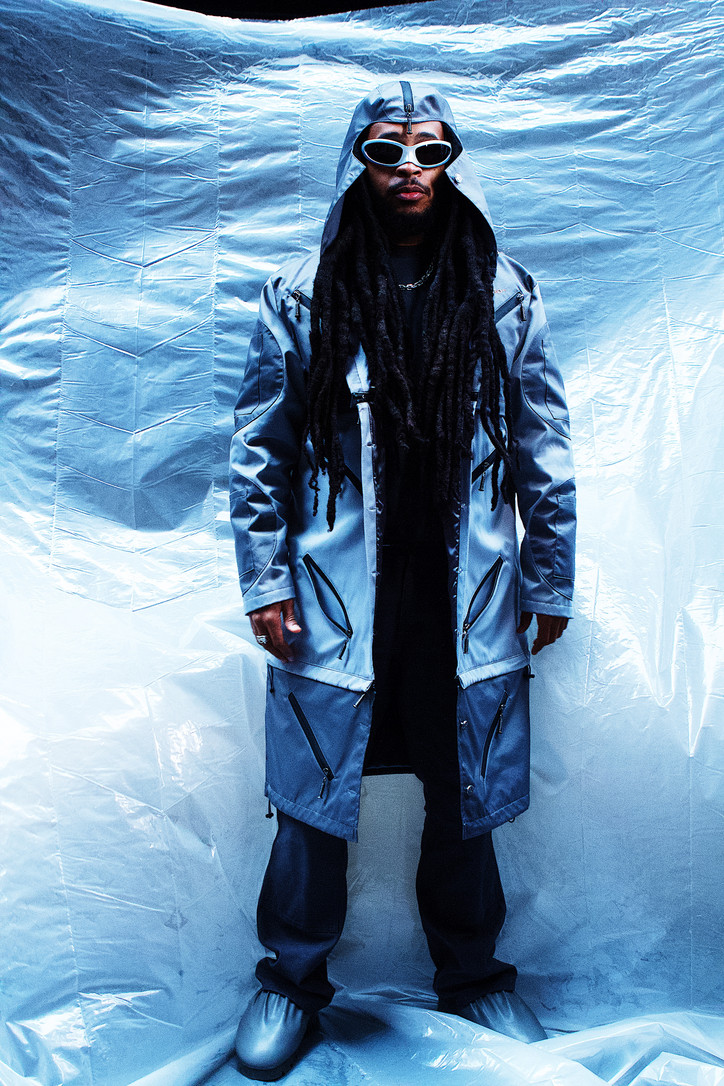
Jacket TOMBOGO, sunglasses BALENCIAGA, shoes YUME YUME, necklace and ring MARTINE ALI, pants CARHARTT, sweater STONE ISLAND.
A lot of your artwork is a lighthearted, tongue-in-cheek commentary on society. Is that an accurate representation of how you see things? That maybe there are problems, but it's not as serious as we may think.
Yeah, that's a good way to look at it. I think I do have a good sense of humor but I'm not the person that people would call funny. But all my friends, I would call them funny. And I love standup comedy. I love comedy in general. And so, I think I have a comedian's perspective on the world, a George Carlin or Dave Chappelle, how they can speak on these topics that are very serious, but in a way that is digestible using comedy. I think that's probably where that comes from. It's a cool thing when people see my artwork and think its funny. Not a laugh out loud thing, but…
It makes you smile.
Yeah, yeah, yeah. For a second and then think about something for a second, which is all you have anyway, with how fast things go these days.
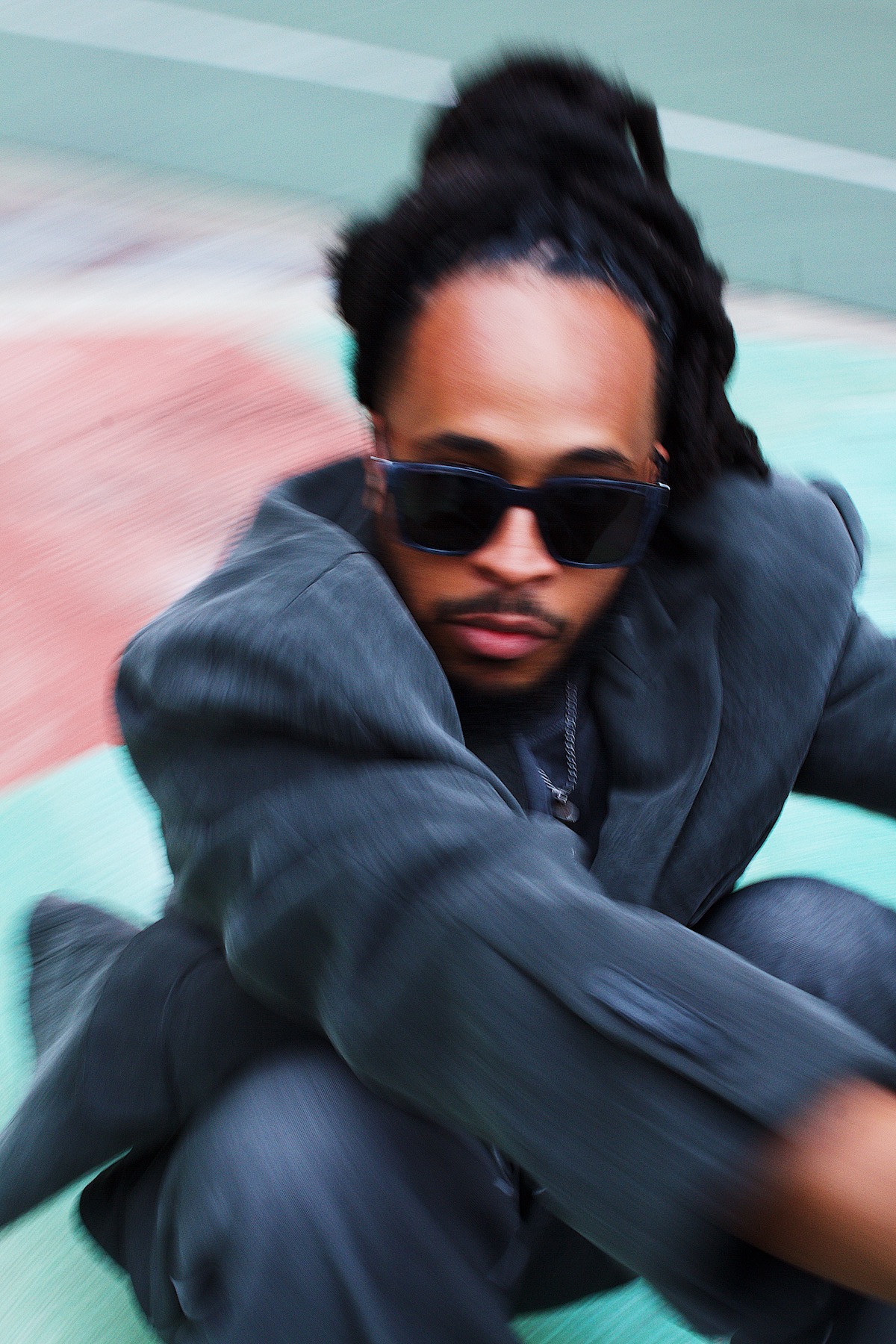
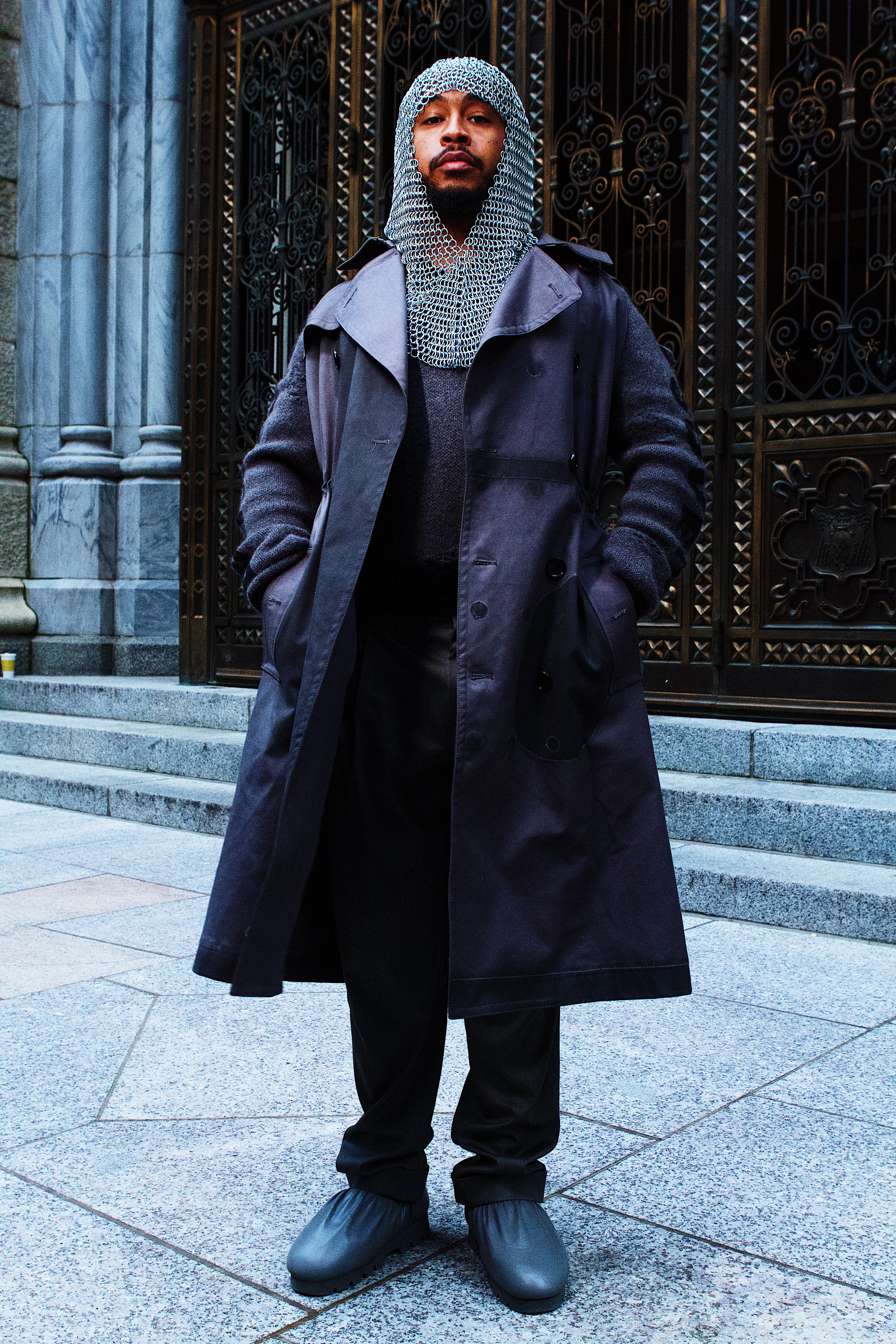
Left: jacket WILLY CHAVARRIA, pants BURBERRY, top MAISON MARGIELA, sunglasses LOUIS VUITTON, necklace TALENT'S OWN.
Right: coat BURBERRY, sweater LIBERAL YOUTH MINISTRY, pants CANALI, shoes YUME YUME, headpiece TALENT'S OWN.
Can you tell me about the homelessness project you're working on?
It's called ‘No More Land’. I got that name because I was going on a rant one day. Somebody was saying that they hope to work with some big artist. Maybe it was Kanye or something. I'm like, 'of course you're going to. Where else is he going to go? Where else? There's no more land.' Eventually, in a long enough timeline, you're going to get to work with who you want to work with. There's nowhere else to go. You can't go to another planet and get talent. You're going to get do what you want to do if you just keep doing it for long enough. And so that's where the name came from. So, I wasn't talking about homelessness when I went on the rant to my friend, but I was looking for a name.
So, I came up with ‘No More Land’ because there's no more land, there's nowhere else for homeless people to go. Just where else are they going to go? The project is my attempt to solve homelessness with design. And when I say 'solve', I don’t necessarily mean there will be no more homeless people but approaching it as if it's a category for commerce that's been ignored. We have camping gear, we have sports gear, we have all this gear for every other category of people's lives, but we don't have homeless gear. This gear for people that don't have a home to use. So, when I say, 'solve it', I don't mean get all of them off the street. Some of them want to be on the street. Some of them are so mentally ill or so addicted that they'll never be able to hold down their own house regardless. So how do we build things for those who are inevitably going to be on the street? We're approaching it the wrong way, I think.
Yeah, it doesn't have to just be house or no house.
Or house or no resources. And even this thing I'm wearing right now is a wearable sleeping bag. I found them and thought they could be cool. Then I started gathering references for all these things that were adjacent; Craig Green x Moncler, and thought that would be cool if it was for homeless people. I started collecting all of these references and just decided to just launch it one day prematurely. I just wanted to get it out there and start attracting designers and like-minded people to help me do it. Because it's like a 50-year project. I'm not going to do it in a couple years. I'm calling it a 'life work', and I'll just work on it for the rest of my life until it's in a different place than where it is.
We spoke previously about you primarily working in New York and LA despite living in Florida, and the sense of disconnect that goes with that. Is that disconnection something you enjoy, and do you think it helps you creatively?
Like I said earlier, I'm very impressionable. So if I'm around painters, I'm going to start painting. If I'm in LA all day, I'm going to start being an LA rat, how people are there, drugs and all this stuff. So, because I'm so fragile in that way, or impressionable in that way, I think it helps me just stay grounded. And then of course, my family is in St. Petersburg, so I may be disconnected from the work, but I’m near my family and friends who I grew up with, and the work is in my head. So, it's not really a disconnect as much as its separation of space. We're not separated mentally. We're on Zoom calls, so it is a physical separation or a physical isolation. Ideas don't really need to be in a certain area of the world. You don't have to be in LA to work on things in LA. So I don't really feel disconnected. I feel like I need the space and quiet, you know what I'm saying? Because I'm a fragile person.
You hear about people going crazy all the time. "Oh, he used to be a cool guy. I don't know what happened to him, he just..." And I just didn't want that to happen to me but recognized that it possibly could if I stay in unhealthy environments too long. So just more for longevity that I chose to be not in the mix. I tried it though. I tried to live here, I tried to live in LA. It's too unhealthy, for me.
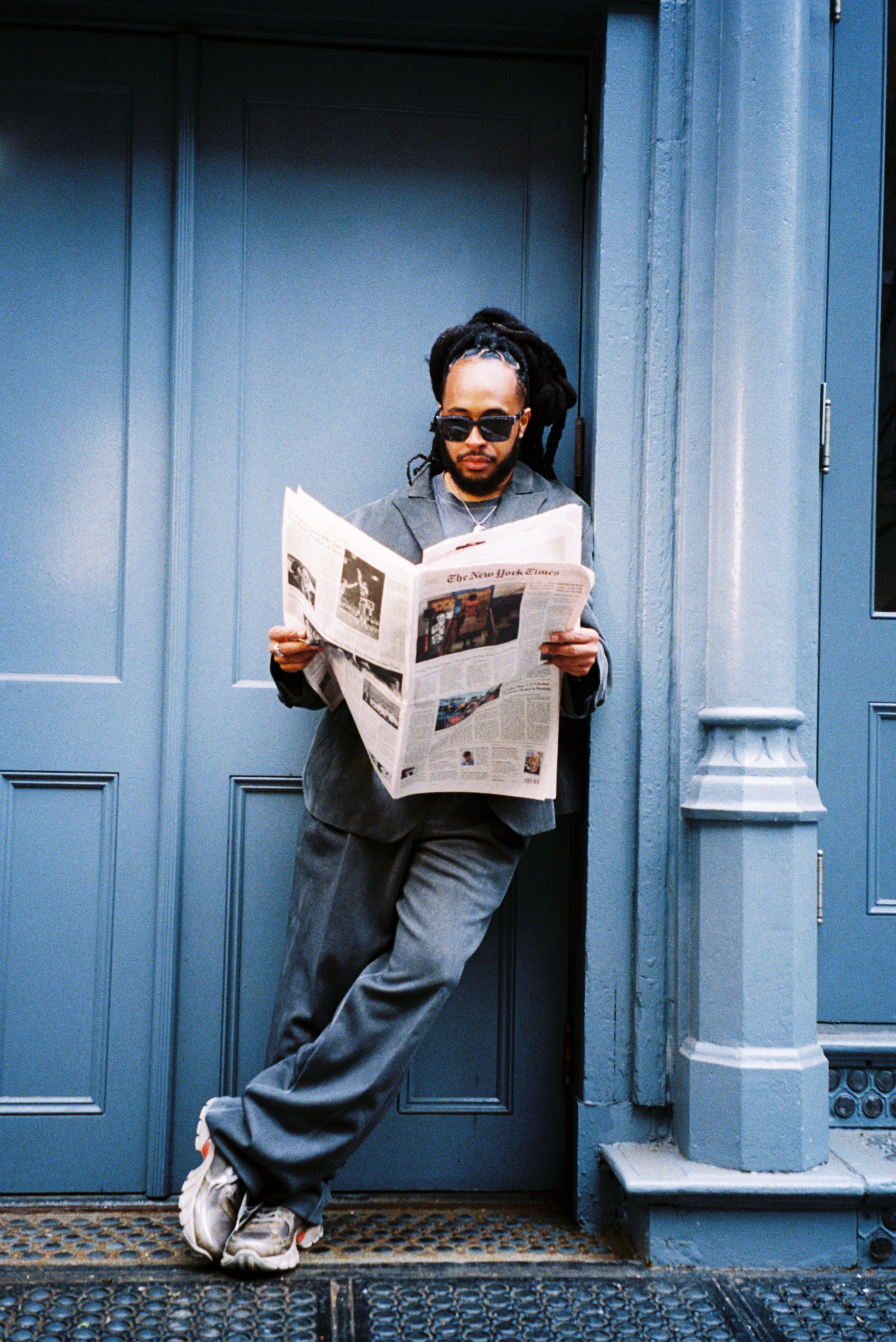
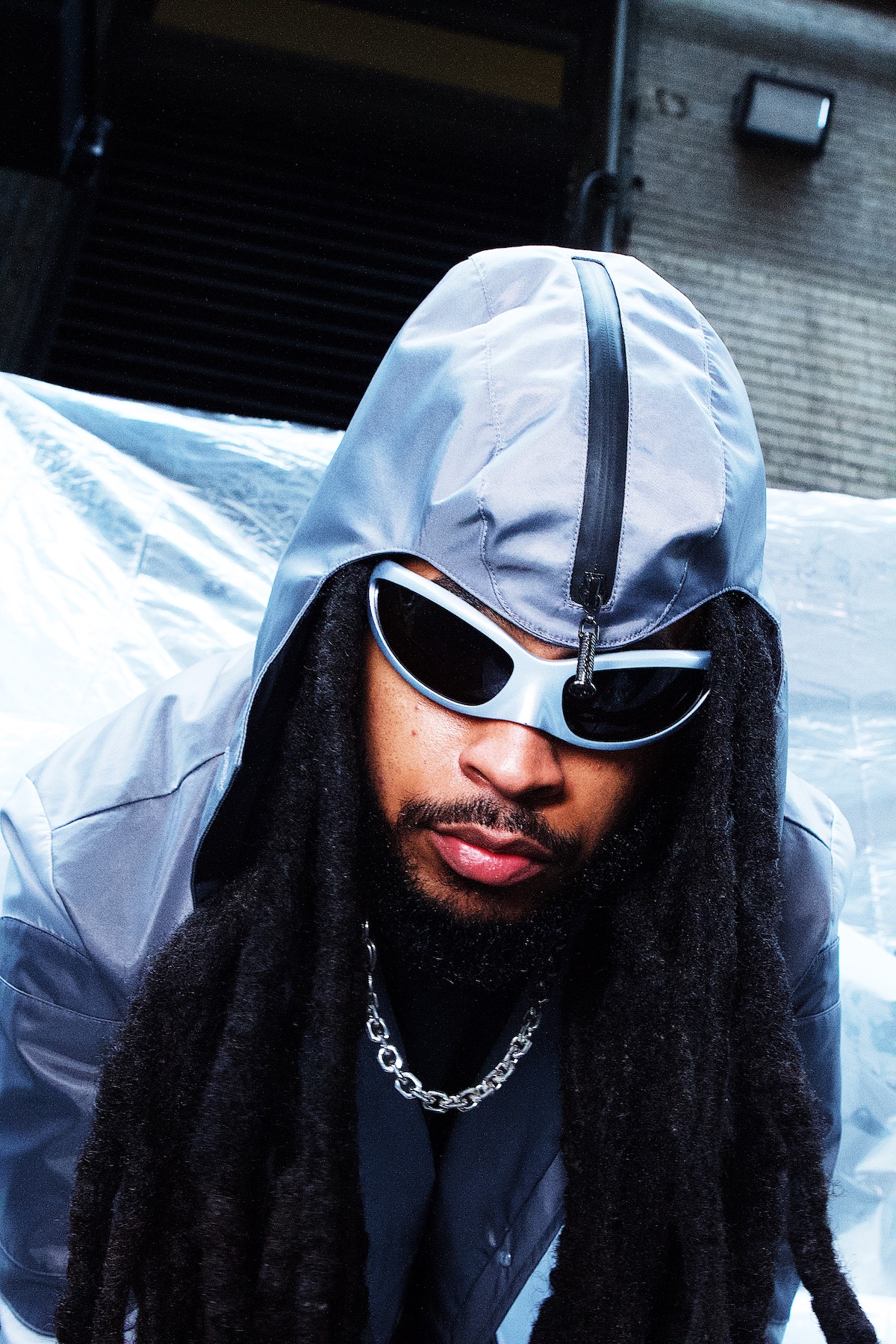
Left: jacket WILLY CHAVARRIA, pants BURBERRY, top MAISON MARGIELA, sunglasses LOUIS VUITTON, shoes HERON PRESTON, necklace TALENT'S OWN. Right: jacket TOMBOGO, sunglasses BALENCIAGA, necklace MARTINE ALI.
Why'd you remove yourself from Instagram in a time where so many creatives feel it's essential to be on it?
To the same point of it being unhealthy for me. Like I said earlier in this conversation, I never do things for one reason. It wasn’t just I'm addicted to Instagram so I'm going to quit. That's one reason. But part of it is me being impressionable. If I'm seeing somebody designing clothes in Paris, it's like, I got to go to Paris right now and I'm going to start looking at flights. Even if I don't buy it, that's distracting me for an hour of my day now. I see somebody making a painting. See Nate taking some photos. See you working at office Magazine. I'm thinking maybe I should get a job for a magazine. Maybe I should start my own magazine. I'm just so easily distracted and so that's part of it, me not wanting to be distracted.
And then the comparison is the thief of joy. Why am I not in Paris, in a mansion with a Lamborghini right now? Why am I not? And so, I was tired of having my joy robbed. I'm a simple dude. I don't need any of that. I'd like a Lamborghini. But I don't need that. Part of it was not wanting my joy robbed. Maybe it's not a day-ruining thought. It ruins five minutes of my life, or two minutes. So, it's taking my time back and taking my life back. And I wasn't posting anything. I wasn't doing anything on there. And so, I'm literally just consuming.
I think as creatives, comparing yourself to other artists can be such a damaging thing. Which is basically what Instagram is; comparing yourself to other people.
It’s a comparison machine. It's all it is. Like, hey, look at me. Hey, look at me. Hey, look at me. You're just looking. And our brain, as humans, is designed to compare ourselves to people, partly for survival. If our cave neighbor made a spear, it's in our best interest to observe and compare, oh, I need a spear. It's in our best interest to be like that. I need to learn how to make fire because his family's warmer than mine and my family's shivering in the cold. So, we're designed as humans to compare ourselves. We’re social creatures. So, it's not anybody's fault except the creators of Instagram. It's not anybody's fault that they're addicted or compare themselves to people when they're on Instagram. You're either on Instagram, comparing yourself to people, or you're just not on Instagram. It's not like you can turn off that thousands of years of evolution designing us to do that. And it's only been 30 years in technology.
That's interesting because I kind of assumed it was a modern-day thing.
No, for survival we've had to compare ourselves to other humans. ‘Compare’ may not be the word, but we had to see ourselves in relation to other humans since the beginning. Since we were monkeys or whatever. Because if they got coconuts or found the bananas, where's the bananas? My family's hungry too. So, I'm going to follow you there and go do it too. Monkey see, monkey do, right. You know what I'm saying?
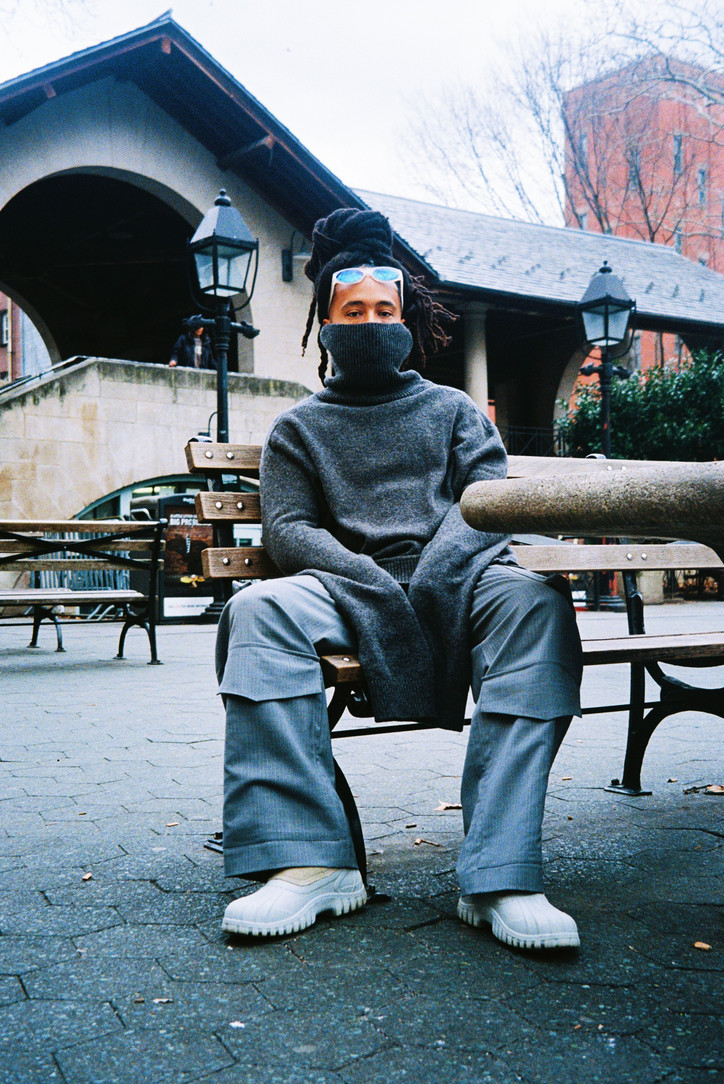
Sweater RAF SIMONS, pants WINNIE, shoes YUME YUME, sunglasses FLATLIST.
How do you feel about the direction technology is steering art?
On a good day, I feel good about it. On a bad day, I feel bad about it. On a cynical day, I'm like, oh, fuck this man. It's not going in a good direction. But as I get older, I'm observing more and being able to separate myself from certain technologies. People are going to be painting forever. They're going to paint forever. They're going to make songs forever.
I think it's going to help art at the end day. I think technology is going to help art, and there’s going to be different branches of it. There's going to be the purists, the naturalists, there’s going to be people who play around with technology and become cyborgs and their art is going to look a certain way. I think we live in a time where you can do and live in any era from history.
You can be a 1950s, prohibition era photographer, and only shoot film, only drink beer that you brewed yourself, only wear wool and tweed. You can choose to be in any era. And so, I think there’ll be branches. I don't think it's going to be such a heavy hand like, oh, technology did this to art. I think there’ll be a branch of people who use technology for art. Then it'll be everybody else. A hundred thousand other branches. But technology's allowing us to live and for every trend to be happening at once, right now. If you want to be a 1980s kid, disco, post disco kid, you can do that right now, you know? All the trends are happening at once right now. People are wearing skinny pants, people are wearing bell bottoms, all at once and that's because of technology. Overall, I think it's a good thing.
